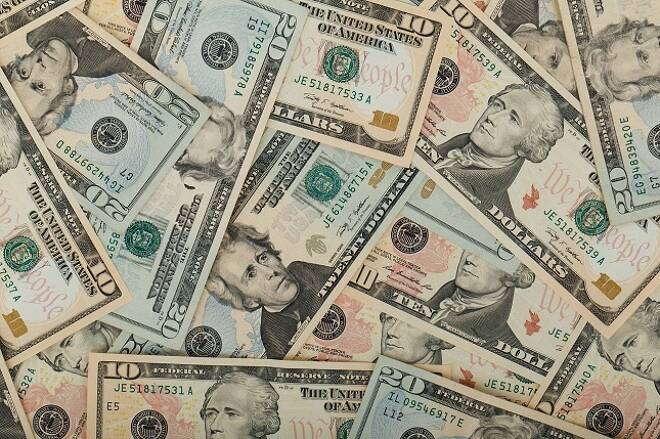Advertisement
Advertisement
U.S. Dollar Weakens as Fed’s Powell Hints End of Policy Tightening Cycle is Nearing
By:
The Australian Dollar finished higher last week despite an extremely volatile trade. The New Zealand Dollar was driven higher last week by strong domestic data and a weaker U.S. Dollar. A bullish outlook for U.S. interest rates helped widen the spread between U.S. Government bonds and Japanese Government bonds, making the U.S. Dollar a more attractive investment.
The U.S. Dollar went for a wild ride last week against a basket of major currencies as traders reacted to political, economic and Fed news before settling lower.
For the week, the September U.S. Dollar Index settled at 95.063, down 0.918 or -0.96%.
The dollar started the week under pressure with some of the selling being driven by dovish comments from FOMC member Raphael Bostic, who said on Monday that he believes that relatively tame inflation warrants only one more rate hike in 2018. Late in the session, a comment by President Trump spiked the market lower into the close.
Trump criticized Fed policy for the second time in a month on August 20 saying, “I’m not thrilled with his (Jerome Powell) raising rates, no. I’m not thrilled.” He went on to say that “We’re negotiating very powerfully and strongly with other nations. We’re going to win. But during this period of time I should be given some help by the Fed. The other countries are accommodated,” Trump said.
The U.S. Dollar recovered a little on Wednesday and Thursday after the minutes of its July 31 – August 1 FOMC meeting, revealed that the central bank plans to continue its gradual pace of rate increases. It further added that Fed officials are wary of tariffs hurting the current economic recovery but are waiting to see evidence of widespread damage in economic data.
Weekly gains were erased on Friday after a key speech by U.S. Federal Reserve Chairman Jerome Powell. In his widely expected speech before a group of major central bankers at the Jackson Hole, Wyoming symposium, Powell said he anticipates a slow and steady pace of rate hikes as the central bank looks to balance economic growth and curbing lofty asset prices.
Despite Powell’s generally upbeat commentary on the state of the economy, some U.S. Dollar investors pointed out that the central bank chief seemed content with where interest rates are. This suggested that the Fed was nearing neutrality, a state where the economy needs neither a rate hike nor additional stimulus.
At this time, the dollar would become a less-desirable investment because the other major central banks would likely continue to raise rates.
In economic news, the Commerce Department said on Friday Core Capital Goods Orders rose 1.4 percent last month after an upwardly revised 0.9 percent increase in June. Economists were looking for a 0.4 percent increase in July after a previously reported 0.2 percent gain in June. Core capital goods orders increased 7.2 percent on a year-on-year basis.
Australian Dollar
The Australian Dollar finished higher last week despite an extremely volatile trade. The currency traded better early in the week in reaction to a weaker U.S. Dollar, but was crushed mid-week with the release of hawkish U.S. Federal Reserve meeting minutes and political turmoil in Australia.
The Aussie firmed enough on Friday to recapture its earlier loss, led by the lifting of political uncertainty following the ousting of Prime Minister Malcolm Turner and the appointment of Scott Morrison as the new leader. The Aussie also received a boost after the greenback weakened in response to dovish comments from Fed Chair Jerome Powell, who hinted that the central bank was getting close to normalization.
For the week, the AUD/USD settled at .7327, up 0.0010 or +0.13%.
Early in the week, Reserve Bank of Australia governor Philip Lowe said that interest rates in Australia will rise, “at some point”, and urged borrowers to get their house in order to prepare for higher interest expenses. Lowe also lashed out at Australia’s banking system, told Australians to keep the recent housing price slump in perspective, and slammed the economic policies of U.S. President Donald Trump.
Additionally, the RBA reiterated that it had no plans to adjust monetary policy in the near term in its August monetary policy meeting minutes released on Tuesday and pointed to potential risks from global trade tensions and the impact of a drought that has hit rural Australia.
New Zealand Dollar
The New Zealand Dollar was driven higher last week by strong domestic data and a weaker U.S. Dollar. Domestically, quarterly Retail Sales rose 1.1%, up from 0.3%. The forecast called for a 0.4% gain. Quarterly Core Retail Sales were up 1.4% versus an estimate of 0.8%. The previous quarter was 0.6% higher. The GDT Price Index came in down 3.6%.
The NZD/USD settled at .6690, up 0.0055 or +0.83%.
Japanese Yen
A bullish outlook for U.S. interest rates helped widen the spread between U.S. Government bonds and Japanese Government bonds, making the U.S. Dollar a more attractive investment. The Dollar/Yen was strong all week, following a technical reversal bottom on August 21. The Forex pair was helped by the hawkish Fed minutes. However, the Japanese Yen strengthened on Friday after Fed Chair Powell hinted that policymakers were nearing the end of its monetary policy tightening cycle.
The USD/JPY settled at 111.268, up 0.762 or +0.69%.
There were no major reports out of Japan last week, however, All Industries Activity fell 0.8%, Flash Manufacturing PMI came in at 52.5, close to the 52.4 estimate and National Core CPI came in slightly below expectations at 0.8%.
About the Author
James Hyerczykauthor
James Hyerczyk is a U.S. based seasoned technical analyst and educator with over 40 years of experience in market analysis and trading, specializing in chart patterns and price movement. He is the author of two books on technical analysis and has a background in both futures and stock markets.
Advertisement
